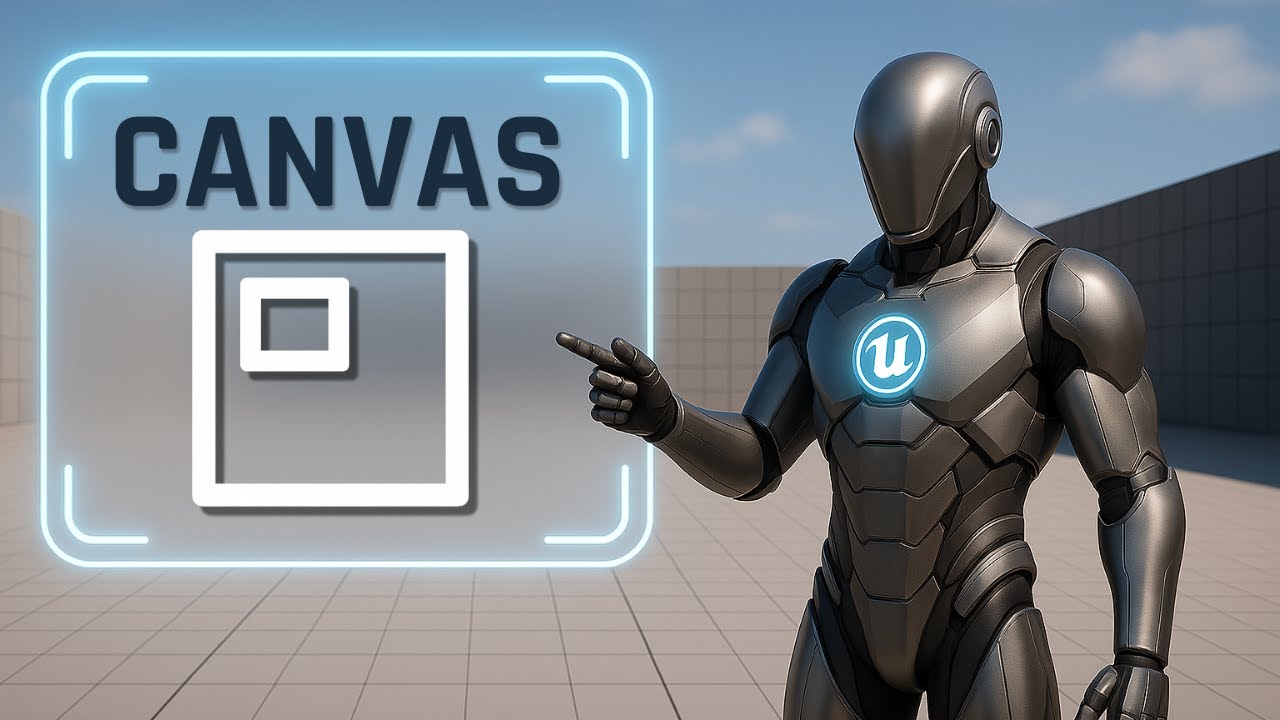
Learn Unreal Engine Canvas Panel in 3 Minutes!
Master Unreal Engine’s Canvas Panel for precise UI layouts. Anchors, alignment, ZOrder, nesting, and layout explained in detail.
This is Rambod, and in this short but important lesson we’re covering the Canvas Panel in Unreal Engine’s UMG system.
Although the video runs just 3 minutes, the Canvas Panel is one of the most critical building blocks of Unreal UI. Unlike auto-arranging containers (Horizontal Box, Vertical Box, Uniform Grid), the Canvas Panel gives you absolute freedom — you decide exactly where and how widgets are placed. That makes it the default root for most HUDs, menus, and in-game overlays.
1) What Is the Canvas Panel?
- A layout container that allows absolute positioning.
- Doesn’t auto-adjust or auto-align children — you set every position, size, and anchor manually.
- Perfect for HUDs, floating windows, menus, or popup panels where elements must stay fixed.
- Often the root container of a Widget Blueprint.
2) Designer Preview Controls
When you first open a User Widget Blueprint with a Canvas root, notice two dropdowns at the top of the Designer:
-
Screen Size (left side):
Simulates how the UI will look on different devices — PC monitors, iPhones, Android models, tablets.
Example: Switch to “iPhone 12” to see how your layout scales. -
Preview Bounds Mode (right side):
Controls how the root canvas fills its space.- Fill Screen: Expands to entire viewport.
- Custom: Lets you manually set width/height.
- Desired: Shrinks/expands based on widget content.
👉 These two together help test responsive layouts while still using absolute positioning.
3) Canvas Slot Properties for Each Child Widget
Every widget placed inside a Canvas gets a Canvas Slot, with properties that control its exact placement:
🔹 Anchors
- Defines the reference point for positioning.
- Examples: top-left, center, bottom-right, or stretch between edges.
- Determines how the widget scales when the screen changes size.
🔹 Position (X, Y)
- Offset relative to the anchor.
- Example: Anchor top-left + X=100, Y=50 → widget appears 100px right, 50px down.
🔹 Size (X, Y)
- Explicit width/height.
- Can use Size to Content for text/buttons that auto-resize.
🔹 Alignment
- Defines the widget’s pivot relative to anchor.
- Example: Alignment X=0.5, Y=0.5 → centers the widget on its anchor.
- Extremely useful for middle-screen elements like pause menus.
🔹 ZOrder
- Determines layer priority.
- Higher ZOrder → rendered on top of lower ones.
- Example: Set button ZOrder > background image to make sure it’s clickable and visible.
4) Nesting Canvas Panels
You can nest canvases inside each other:
- Root Canvas → fills the whole screen.
- Inner Canvas → absolute positioning for localized UI windows.
- Example: Root manages HUD, nested canvas handles a floating inventory window.
This nesting allows:
✅ Localized absolute positioning
✅ Popup panels, drag-drop areas
✅ Combining with animations and scripting for flexible layouts
5) Why the Canvas Panel Matters
- It’s the default backbone of most Unreal UMG widgets.
- Offers pixel-perfect placement when needed.
- Works great in combination with other layout panels (e.g., put a Vertical Box inside a Canvas slot for auto-arranged children within a fixed area).
- Essential for HUDs, crosshairs, dialog windows, minimaps, floating UI, and more.
Subtitle Expansion (Full Tutorial Flow)
“This is Rambod and we’re covering the Canvas Panel in Unreal Engine UI. The Canvas Panel is Unreal Engine’s most flexible layout container and often the default root. Unlike layout boxes, it gives you absolute positioning control. By default, it fills the screen, but with Designer dropdowns you can simulate devices and switch preview modes like Fill Screen, Custom, or Desired. Each widget inside a Canvas gets its own slot with properties: Anchors, Position, Size, Alignment, and ZOrder. Anchors tie widgets to screen edges or centers. Position is offset from anchor. Size is fixed or auto. Alignment sets pivot. ZOrder decides which widget renders on top. You can even nest Canvas Panels — root for fullscreen, child canvas for floating panels or popups. This gives both freedom and structure. The Canvas Panel is the backbone of most UMG layouts. Master anchors, alignment, and slots, and you’ll build flexible, professional UI.”
Wrap Up
The Canvas Panel is simple at first glance, but mastering its slot system (anchors, alignment, ZOrder) is essential for professional Unreal UI.
- Use it as the root for most widgets.
- Combine it with Designer preview tools to test across devices.
- Nest canvases for advanced, modular layouts.
👉 Watch the full 3-minute tutorial here: YouTube Link
👉 Read more UI breakdowns on rambod.net
👉 Subscribe to Rambod Dev for the complete Widget Blueprint series.